This article about epithalamia was published in ‘Boek en beeld/Book and image’, in: Jaarboek voor Nederlandse boekgeschiedenis/Yearbook for Dutch Book History 26 (2019), pp. 101-121.
Legenda
KBH Koninklijke Bibliotheek Den Haag
UBA Universiteitsbibliotheek Amsterdam
UBL Universitaire bibliotheken Leiden
GA Gemeentearchief Amsterdam
Catalogue of épithalames by Bernard Picart
All the epithalamia were published as title prints or title vignettes, in marriage brochures with poems, but they were also published
I I715
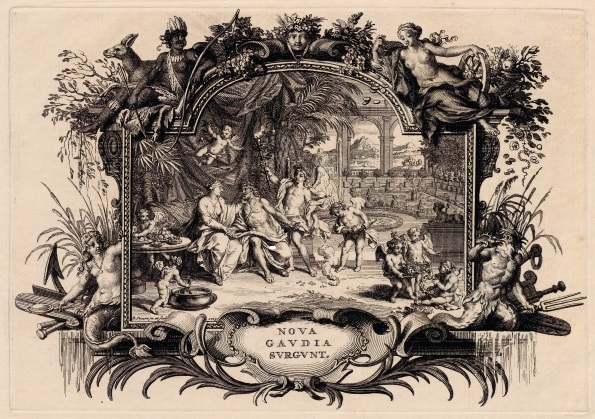
Allegorical representation with an amorous couple, Hymen and putti in an ornamental frame with the motto on a cartouche: Nova Gaudia Surgunt.
Etching and engraving, 127 x 182 mm, signed at lower left within ornate frame: B. Picart in. et scul. 1715.
Large vignette on the occasion of the silver wedding feast of Jan van Vollenhove en Maria Palm in 1715, Haarlem. Brochure unknown.
Commentary
The Mennonites Maria Palm (Haarlem 1670-Amsterdam 1745) and Jan van Vollenhoven (Amsterdam 1670-Amsterdam 1737) celebrated their silver wedding in 1715; on this
The couple is sitting on a sofa, situated in an abundant garden which is an allusion to the name Vollenhoven. The palm trees are likewise referring to the last name of the spouse Palm. Hymen, the wedding god, is standing beside the couple with his flaming torch as if to show they are still in love with each other. He is pointing to Cupid who drops a new arrow from his quiver to rekindle the love fire while the first one still smokes. Six cupids are eager to prepare the feast, like making garlands, pouring in a pot, and decorating. At the upper left the figure of America with a moose/eland behind her symbolizing the trade of the couple. At the upper right Fortuna signifies their wealth/riches. Below a Siren and a Triton exemplify that the trade of the coupe mainly takes place over sea. The motto Nova gaudia surgunt means New joy rises. Source: Christanus Campililiensis, c. 1330 Officia 19.91
II 1716
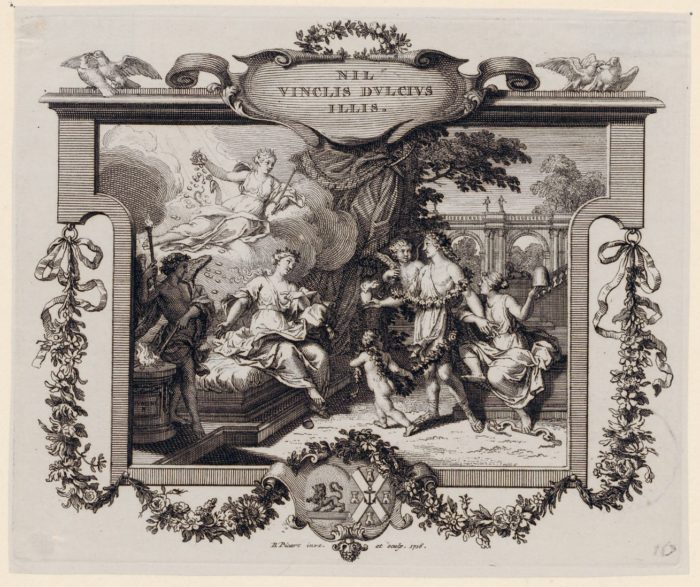
Allegorical representation with a young man who offers a young woman, seated on a bed, a burning heart, in an ornamental frame with the motto on a cartouche: Nil vinclis dvlcivs illis’
Etching and engraving, 119 x 145 mm, signed at lower centre below ornate frame: B. Picart inve. et sculp. 1716.
Large vignette on title-page (A1r) and explanation (A1v) in Bruiloftzangen voor den heere Dick van Lennep, de jonge, en mejuffrouw Catharina de Neufville. Vereenigt den 7den juli, 1716, Amsterdam: Hendrik vande Gaete, 1716. 4o
KBH: 853 C 140 (lacks A1, 2)
GA: Len (2443)
Commentary
The Mennonites Dirk van Lennep (1693-1755) married Catharina de Neufville (Meerenberg Heemstede 1684-Amsterdam 1729) on the 7th of July in 1716. They lived in Amsterdam, Herengracht 476, in the so called .’Gouden Bocht’ (Golden Bend), where the rich merchants settled. It was originally bought by David de Neufville (1654-1729), father of Catharina and a wealthy merchant in Amsterdam. After his death in 1729 Catharina inherited the place. The couple rebuilt it circa 1730 in a Louis XIV style. [2]
Around 1730 they were owners of the country estate ‘Meerenberg’ at Heemstede, which belonged to the property of the father of Catharina. The couple must have been quite rich because at the same time Dirk also bought the adjoining estate ‘Leeuwenberg’. But already in 1732 it was sold to Catharina’s sister Petronella de Neufville (1688-1749), widow of Jacob van Lennep (1686-1725).[3]
A young man is held back by Liberty who has a yoke at her feet, to signify that he is about to lose his freedom. But Amor is guiding him while he is offering a burning heart to his bride who is sitting on a bed. He is enchained with flowers by Cupid. His bride is pointing at Hymen who is lighting his torch as if to show how lucky the groom is to marry her. Amor tries to persuade him to surrender, and Juno, who is scattering coins and jewels over them, designates the great riches which they both possess. Their coats of arms are united in a cordate cartouche decorated by festoons of flowers. At the upper centre the scene is crowned by a cartouche with the motto Nil vinclis dulcius illis meaning Nothing is sweeter than these shackles which is referring to the garlands by which the groom is enchained.
Op de tytelprent
Laat los, o Vrijheit: want de Liefde toont haar kracht. | De minnaar komt, geboeit, zijn hart ten offer draagen | De Schoone, welker deugt hem ’t hoogste kon behaagen. | Zij, die gerust en stil op ’s Hemelsch schikking wacht, | Wijst hem naar ’t Echtaltaar, daar Hymens fakkels branden, | Dus kroont de Trouwgodin met zegen d’Echtebanden. | W.
III 1718
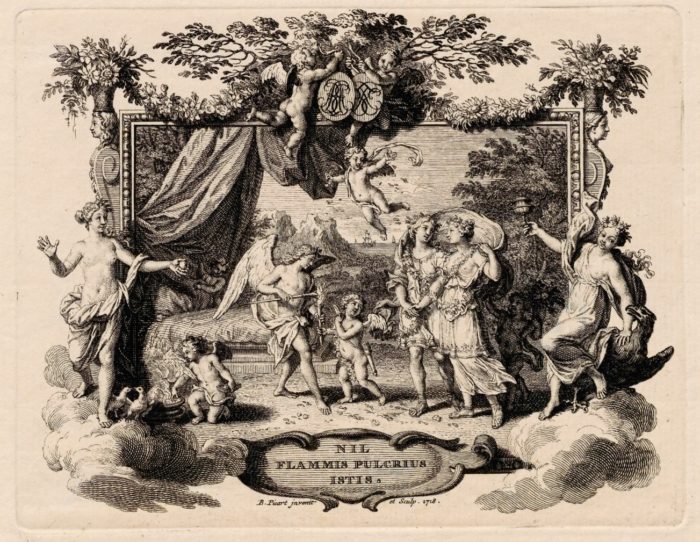
Allegorical representation with a couple, decorated with garlands of flowers, in an ornamental frame with a motto on a cartouche Nil
Etching and engraving, 113 x 144 mm, signed at lower
Large vignette on title-page(A1v) and explanation (A1r) in Gezangen ter bruilofte van den heere Arent Bosch, en jonkvrouwe Eletta Thesingh, vereenigt den 3den van grasmaant
[april]
, 1718, Amsterdam: Willem en David Goeree, 1718. 4o
UBL MNL: 1256 A 37
Commentary
Arent Bosch and Eletta Thesingh got married on the 3rd of April 1718 in Amsterdam. According to one of the poems in the brochure he was trading hemp, leather, sable skins, and talk from Russia, which made him a wealthy merchant.
A couple is enchained with garlands of flowers by Cupids. They send them to Hymen who is standing next to the nuptial bed, lighting a torch. Several little loves are eager to burn perfumes to spread flowers. In the background there is a sea referring to their business. At the left is Venus who offers the couple her golden apple to signify the beauty of the bride. At her feet are two turtle doves and a Cupid is lighting up a fire. On the right side is Hebe with a beautiful drinking bowl with nectar in her hand, thereby preserving the couple’s eternal youth. She is accompanied by the eagle of Zeus, her father. The ornate frame is crowned by two Cupids who are a holding up the initials of the couple like a trophy. Below in a cartouche the motto Nil flammis pulcrius istis or Nothing is more beautiful than these flames.
UITLEGGING | Van het TAFEREEL. | Terwyl de Jeuchtgodin den drank schenkt van de Goôn, | De Bruidt door Venus wordt haar appel aangeboôn, | Ontsteekt Godt Hymen, tot vereeuwiging der Stammen, Zyn toorts aen ’t fakkellicht, het geen Cupido draegt, | Het Huwelykbedt verwacht eene ongerepte maegdt. | NIETS SCHONER DAN DIE VLAMMEN. | P. VLAMING.
IV 1718
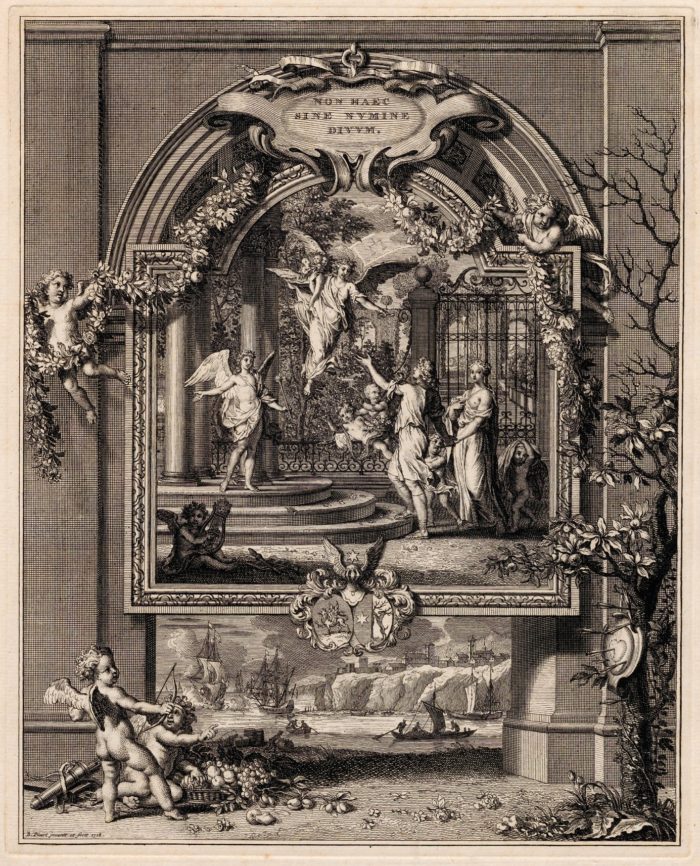
Allegorical representation with a couple that enters the temple of Hymen hand in hand, in a frame with a motto on a cartouche Non haec sine numine divum.
Etching and engraving, 243 x 199 mm, signed at lower left: B. Picart invenit et fecit 1718.
Title-print (~pi~1r) and explanation ( ~pi~1v) in Zangen, ter bruilofte van den heere Abraham Bruin, en jonkvrouwe Debora van Vollenhoven vereenigt den IV. Van herfstmaendt. MDCCXVIII, Amsterdam: z.n., 1718. 4o
KBH 853 G 190
Commentary
Debora van Vollenhoven (1692-1767) is the daughter of Jan van Vollenhoven and Maria Palm (see epithalamium no I). She married Abraham Bruin (1693-?) on the 4th of September 1718.
Within a decorated frame the bridegroom is leading his bride to the Temple of Hymen who is inviting them to enter. Cupids navigate the couple with flowers and garlands. Behind is a magnificent garden, which is an allusion to the name of the bride ‘Vollenhoven’. The genius of September is giving the key of this delightful garden to the groom; in her other hand she is carrying a horn with the heads of little children to indicate a fertile offspring. At the lower left one of the Cupids is playing his lyre, symbolizing the harmony of the marriage. (In the poems the groom is praised for his outstanding play on the lyre.) Outside the frame at the right is an apple tree, at the top the trunk is without fruits, which is an illusion the marriage which has metaphorically speaking not yet bloomed. But below, the branches are full of fruits due to one of Cupid’s arrows right in the middle of a heart on a shield attached to the tree, which expresses the fecundity of the bride’s marriage. At the lower centre the two coats of arms of the couple are combined in a cartouche. In the background ships in the sea refer to their trade with America, and on the coast there are the goods in vessels. The picture frame is crowned by a cartouche with the motto: Non haec sine numine divum or Not without the will of heaven does this befall/ not without divine influence does this come to pass. Source: Virgil, Aeneid, Book 2, line 777.
Uitlegging. | De bruidegom geleidt de Bruidt | Naer Hymens Tempel, op ’t geluidt | Der Lier, die ’t Minnewichtje streelt. | Het vrolyk en aenminnig beeldt | Der vruchtbaerheidt daelt van om hoog, | Zy ziet op ’t Paer met vriend’lyk oog, | Zy schenkt hun dat de waereldt bouwt, | En alle stammen onderhout. | De Volle Hof vol gloet en geur, | Staet heden met geslote deur; | Bedenk wat u te proeven staet | O Bruigom, als zy open gaet, | En de uitkomst van uw echt betoon’, | Dat die geschiedt door gunst der Goon! | P. V. [Vlaming]
V 1719
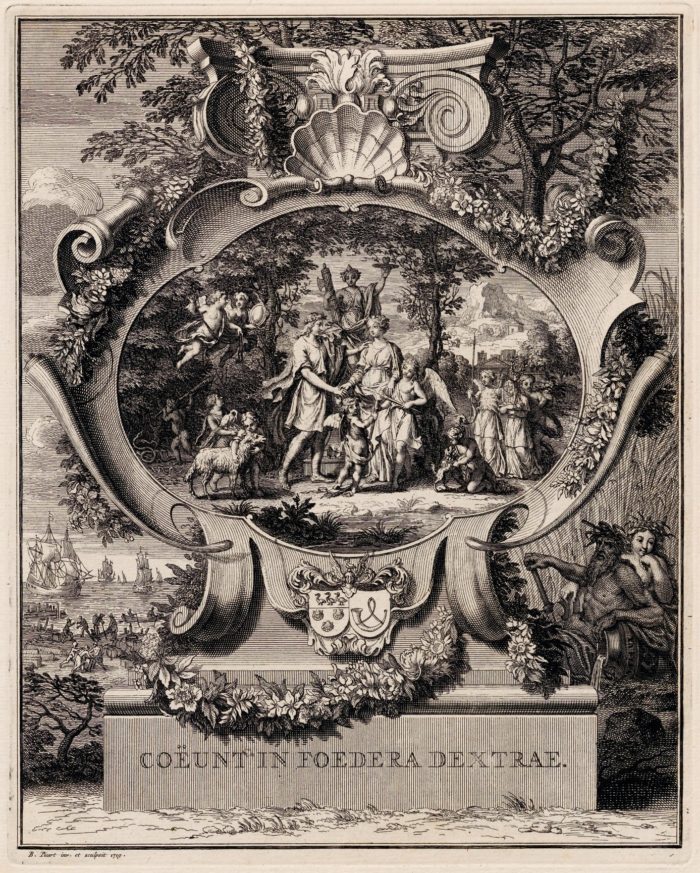
Allegorical representation with couple shaking hands, in an ornamental frame with on piedestal the motto Coëunt in foedera dextrae.
Etching and engraving, 246 x 198 mm, signed at lower left: B. Picart inv. et sculpsit 1719.
Title-print (~pi~1r) and explanation (~pi~1v) in Huwelykszangen. Ter bruilofte van den heere Jacob Alewyn Ghysen junior, en jongkvrouwe Perina Vorsterman. In den echt vereenigt binnen Amsterdam, den 19den van wintermaandt 1719, Amsterdam: Joannes Oosterwyk, 1719. 4o
KBH: Pc 5211
Commentary
On a large cartouche which is attached to the central part of a column, the bridal couple join their right hands. The bride is accompanied by Hymen and Cupid who are lighting each other’s torch. They are all standing before the shrine of Concord (plate with a heart, garland with pomegranate on head, scepter? in left hand). Behind the bride we see her most important qualities: Fidelity (key and dog), Virtue (spear and sun in bossom, laurel in left hand), and ‘Pudeur-Pudicité-Pudency (veil), followed by Abundance (cornucopia). Behind the groom are Gentleness (sheep), Chastity (phoenix), Temperance (bridle), and Prudence (mirror and snake). Still further a Cupid chases Discord represented by serpents, indicating that all dissention should be banished for the purpose of a happy union.
In the background the sea with ships referring to the business of the couple. At the lower bottom the Y and the Amstel as a symbol of Amsterdam, where they live. On the left a seaport and all the goods of their trade. At the lower centre of the cartouche the two coats of arms are united in a smaller cartouche. Below on the pedestal is engraved the motto Coëunt in foedera dextrae or Join the right hands to conclude an alliance. Source: Virgil, Aeneis, Book 11, line 292.
VI 1720
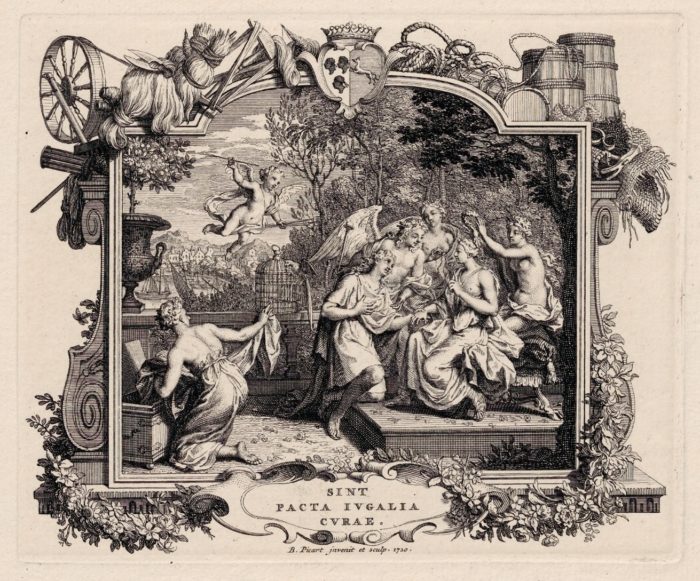
Allegorical representation with Hymen presenting a young man to a young woman sitting on a stage, in an ornamental frame with a motto on a cartouche Sint pacta jugalia curae.
Etching and engraving, 106 x 143 mm, signed at lower centre: B. Picart invenit et sculp. 1720.
Commentary
Large vignette on the occasion of the marriage of Willem Philip Kops (1695-1756) merchant in Haarlem and Johanna de Vos (1702-1758). I have not been able to track down the brochure. The marriage has taken place on 22 September. Combined coats of arms.
A young man on his knees tries with the help of Hymen to persuade his reluctant future bride, who is dressed by the Graces. Cupid points his arrow at her. In the background the city of Haarlem, and ships referring to their business of the manufacture of linen.
VII 1721
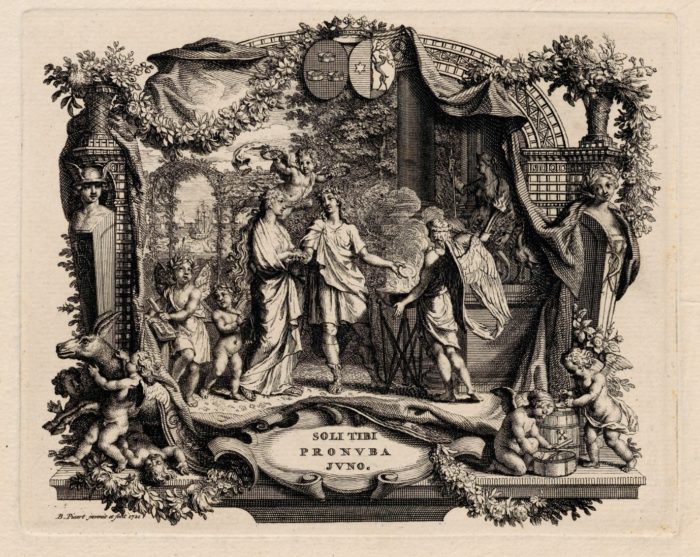
Allegorical representation with a young couple who offer a sacrifice to Juno, in an ornamental frame with a motto on a cartouche Soli tibi pronuba Juno.
Etching and engraving, 118 x 149 mm, signed at lower left: B. Picart invenit et fecit 1721.
Large vignette on title-page (A1r) and explanation (A1v) in Op het huwelyk van den heere Adriaen Maten, en de jongkvrouwe Maria van Vollenhoven. In den echt vereenigd den 6den van bloeimaand, 1721, Amsterdam: erven J. Lescailje en Dirk Rank, 1721. 4o
KBH 853 G 184
Commentary
A wedding set outside a temple of Juno, with the young couple joining hands before a tripod, with the young man pouring the content of a cup into the bowl; at right stands Hymen; a putto is crowning the couple with flower wreaths; in ornate border, with two coats of arms at top, a term on each side, and putti at the bottom.
Motto Soli tibi pronuba Juno/Old Mother-Earth and wedlock-keeping Juno gave the sign; the flash of lightnings on the conscious air were torches to the bridal; Virgil, Aeneid, Book 4, lines 166-167.
VIII 1723
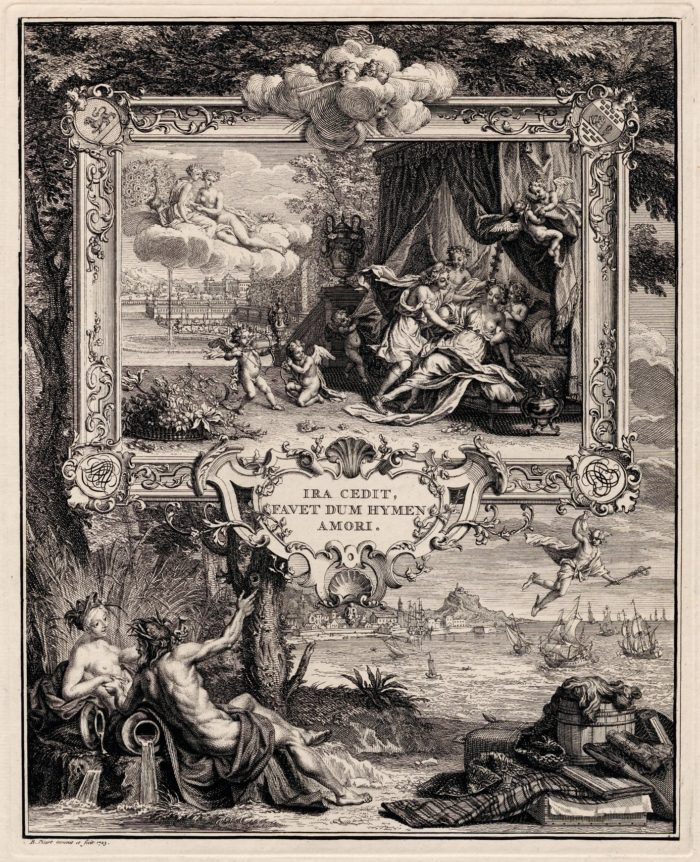
Allegorical representation with a young man who tries to persuade a young woman to share with him the marriage bed in a frame with a motto on a cartouche with the help of Hymen, the love god. ‘Ira cedit, favet dum Hymen Amori.
Etching and engraving, 246 x 202 mm, signed at lower left: B. Picart invenit et fecit. 1723.
Title-print (~pi~1r) and explanation (~pi~1v) in Huuwelijkszangen ter bruilofte van den heere David Leeuw van Lennep, en jongkvrouwe Hester Barnaart. Echtelyk vereenigt binnen Haarlem, den 25sten van bloei-maand, 1723, Amsterdam: Johannes Oosterwyk, boekverkooper op den Dam, 1723. 4o
KBH: 853 G 174
Commentary
A terrace overlooking a garden with, at right, Hymen leading a young man to his bride, who sits on a bed; at top left, Juno and Venus, reclining on a cloud; in ornate border set above a coastal scene, with two river deities at bottom left.
IX 1724
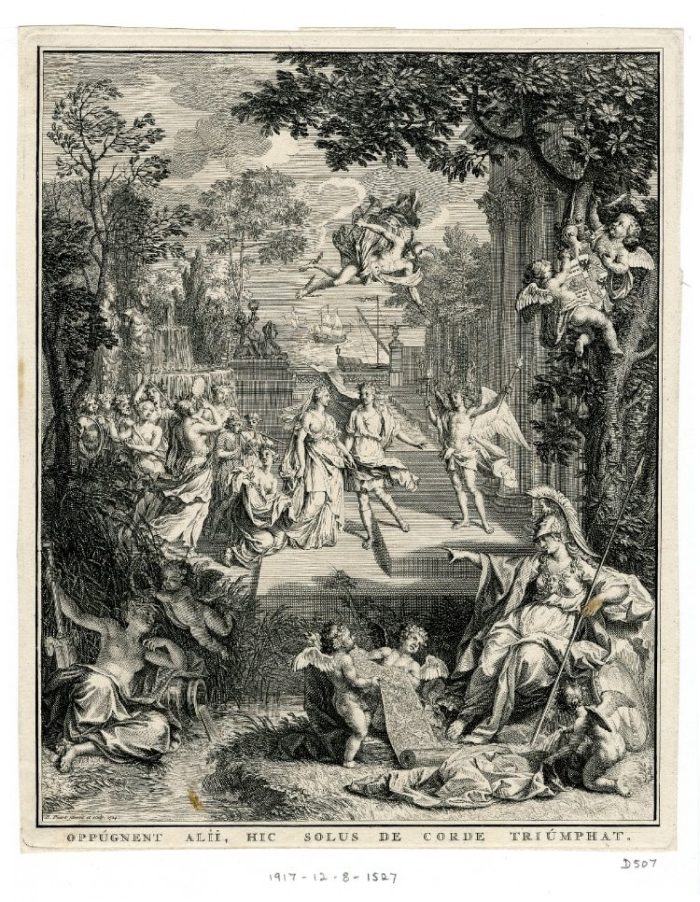
Allegorical representation with Hymen who receives two newlyweds before his temple. Below the motto Oppugnent alii, hic solus de corde triumphat.
Etching and engraving, 252 x 203 mm, signed at lower left: B. Picart invenit et sculp. 1724.
Title-print (~pi~1r) and explanation (~pi~1v) in Huwelykszangen ter bruilofte van den heere Abraham Barnaart, en de jongkvrouwe Engeltje van Hooven. Echtelyk vereenigt binnen Haarlem, den 28sten van lentemaandt, 1724, Amsterdam: Joannes Oosterwyk. Boekverkooper op den Dam, 1724. 4o
KBH: 853 G 178
Commentary
a terrace with young couple, followed by musicians, and standing before a temple, with Hymen greeting them; Mercury hovers above the couple; in the foreground, at right, Minerva leaning against a tree and pointing at the couple.
X 1724
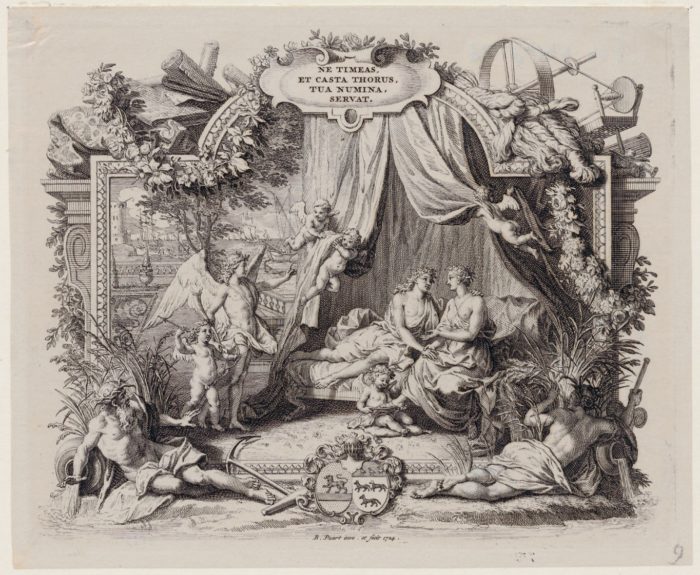
Allegorical representation with two newlyweds sitting on a wedding bed in an ornamental frame with the motto on a cartouche Ne timeas, et casta thorus, tua numina, servat.
Etching and engraving, 121 x 146 mm, signed at lower centre: Picart inve. et fecit 1724
Large vignette on title-page (~pi~1r) and explanation (~pi~1v) in Bruiloftzangen, voor den heere Jacob van Lennep, Dirksz. en jonkvrouwe Susanna Catharina de Wolff. Echtelyk vereenigt in Amsterdam, den XII van herfstmaant, MDCCXXIV, Amsterdam 1724. 4o
KBH 853 G 180
Commentary
couple seated on a canopy bed, with three putti about to close the curtains; at left, Hymen and Cupid; in ornate border, with two river deities at the bottom; finished state.
XI 1726
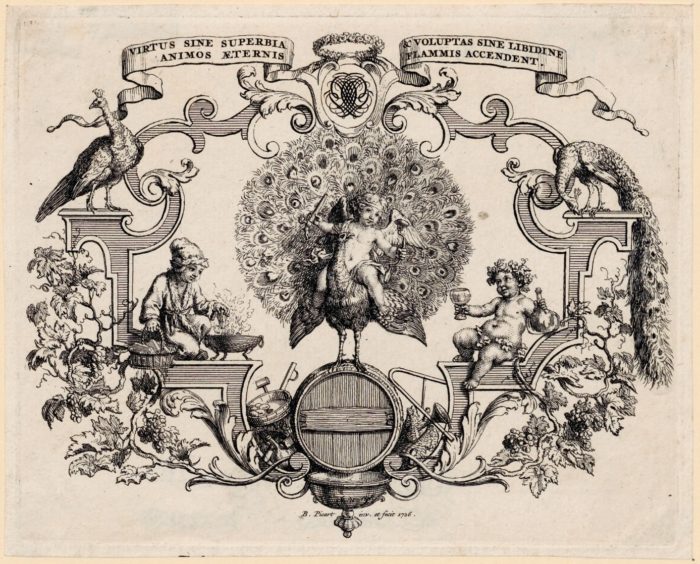
Allegorical representation with Cupid sitting on a peacock in an ornamental frame with the motto on a banderole ‘Virtus sine superbia, et voluptas sine libidine, animos aeternis flammis accendent.
Etching and engraving, 124 x 153 mm, signed at lower centre: B. Picart inv. et fecit 1726.
Large vignette on title-page (~pi~1r) and explanation (~pi~1v) in Huwelykszangen ter bruilofte van den heere Ysbrand Vincent, en jongkvrouwe Johanna Pauw. Echtelyk vereenigt binnen Amsteldam, den 14den van gras-maand, MDCCXXVI, Amsterdam: Willem Barents, boekverkoper, op de Voorburgwal, over de Nieuwe-straat, 1726. 4o
GA: F Vin (4142)
Commentary
ornament with, at centre, a winged putto seated on a peacock perched on a barrel, and holding a bit-brace and a barrel tap; at left, a putto wearing a fur-lined coat putting some wood into a brazier; at right, aputto crowned with ivy, holding glass and wine bottle.
XII 1729
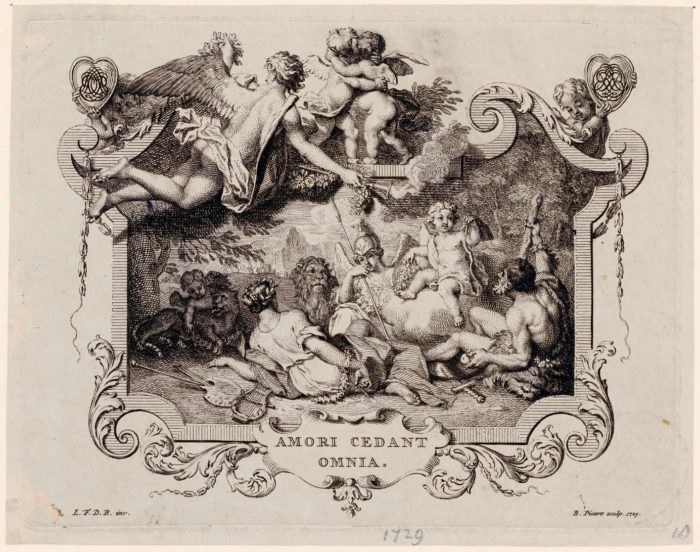
Allegorical representation with Amor sitting on a cloud, surrounded by Minerva, Hercules and the personification of painting, in an ornamental frame with a motto on a cartouche Amori cedant omnia.
Etching and engraving, 118 x 155 mm, signed at lower left: L. F. D. B. inv.; at lower right: B. Picart sculp. 1729.
Large vignette on title-page (~pi~2) and explanation (~pi~1v) in Ter bruilofte van den heere Louis Fabricius Du Bourg, en jonkvrouwe Eva de Kaersgieter, Amsterdam: 1729.4o
KBH: CBG: D 17
Commentary
Minerva, Hercules and a reclining figure resting in a landscape, and Cupid seated on a cloud; in ornate border with, in the upper part, a winged figure hanging garlands of flowers, and two putti embracing.
[XIII 1734?]
Epithalamium; a couple joining hands before an altar upon which are two hearts; above them, a putto holding two torches; at right, a winged figure leaning on a club; at left, several allegorical figures, including Abundance; in ornate border with shield bearing two burning hearts at the top. before 1734? motto ‘Castis mutuo ignibus ardent’.
Etching and engraving, 134 x 148 mm, signed B. Picart inv. et fecit 1736′
Lettered with production detail: ‘B. Picart inv. et fecit 1736’ and
British Museum 1917,1208.1478
Misschien
Ter bruilofte van den heere Frantz Hendrik Thorbecke, en mejuffrouwe Catharina Paauw. Plegtiglyk gevierd binnen Amsteldam, den 7. van wynmaand (=oktober) 1755. (Prent.) Amsterdam, by J.C. Schoots van Cappelle, boekverkoper in de Stilsteeg.
Two poems, signed resp.: Daniel Frantz Thorbecke (brother); Jan Bernard Bierbaum. The print shows the monograms of the bridal couple and the coat of arms of Amsterdam. An explanation of the title-print on A1v. Below the first poem a print, signed: J. Schenksculp; under the second poem a print, signed: B. Picart
Amsterdam, GA: F Tho 3
Un fujet de Noce, dans le goût des XII.
Epithalames.
L’Amour fur fon Thrône avec des demies figures qui s’embrassent des Pigeons qui se bequettent des Feston, Guirlandes
&c.gravez fous sa conduite,
Nota. Ces deux derniers Sujets n’ont point été employés, & pouvoient fervir de Titre à des Vers de Noce , ou à
quelque Livre de galanterie.
Vingt Cinq Vignettes ,
Culs de Lampes, &C desfinez
[1] Julie Mosmulier, ‘Handelende weduwen. Amsterdamse handelsvrouwen in de achttiende eeuw’, Skript. Historisch Tijdschrift 25 (2014) 4, pp. 5-18.
[2] Digitaal Grachtenboek.
[3] https://www.buitenplaatseninnederland.nl/heemstede-meerenberg.html